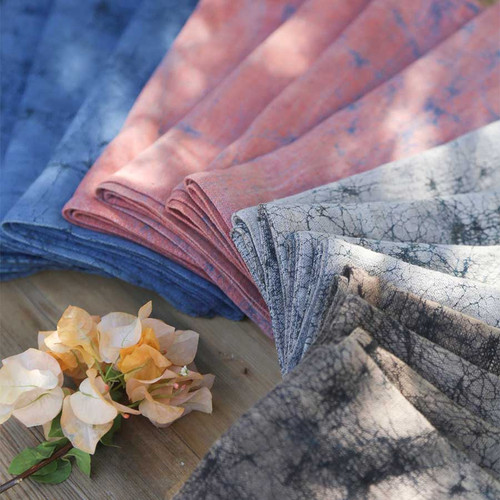Difference Between Azo-Free Dyes and Natural Dyes
Posted by The Ichcha Team on 11th Jul 2025
These days, more and more people are thinking twice about what they wear, not just how it looks or fits, but also how it was made and the dye used. That’s because these things, from the fabric to the dye, can impact not just the environment but even you, the wearer. To promote sustainability and mitigate health risks from fashion, azo-free dyes and natural dyes are great options.
Both azo-free dyes and natural dyes are safer alternatives to azo dyes, but they differ in critical ways. While natural dyes are derived from plants and minerals, azo-free dyes are synthetic and hence not eco-friendly.
Let’s dissect, shall we?
What Are Azo-Free Dyes?
Azo-free dyes are synthetic dyes produced without the use of harmful azo compounds. In case you didn’t know, azo dyes are a massive class of synthetic dyes that release aromatic amines, some of which are known carcinogens (they can cause cancer!). Azo dyes have been widely used in the textile industry because they’re cheap, versatile, and offer diverse colors.
Due to their ease of production and versatility, azo dyes make up a whopping 70 percent of the 9.9 million tons of industrial dyes used globally. That’s tons of potential health risks to both the people dyeing the textiles in factories and consumers wearing them.
Azo-free dyes are a response to that problem. Basically, azo-free dyes are synthetic dyes that do not contain azo compounds, making them a safer alternative. However, azo-free dyes are still synthetic and are made from chemical-intensive processes.
Benefits of Azo-Free Dyes
- Safe for skin and workers: The biggest advantage of azo-free dyes is they are safe on your skin as they do not contain harmful azo compounds.
- Good colorfastness: I find that azo-free dyes often offer stronger colorfastness than natural dyes, which means your fabric won't fade as quickly.
- Wider color range: Unlike natural dyes, azo-free dyes offer a wider range of colors as different kinds of chemicals are easily mixed to obtain various, consistent shades.
- It’s cheap: Like azo dyes, azo-free dyes are easy to manufacture in volumes large enough to handle the enormous global demand for fast fashion. This is unlike natural dyes, which are manually extracted from plants and minerals.
Downsides of Azo-Free Dyes
At the end of the day, azo dyes are still chemicals and may involve the use of petroleum-based ingredients. This means they’re harmful to the environment.
If you’re an eco-conscious consumer, azo-free dyes may not be the best solution for you.
Natural Dyes: A More Sustainable Alternative
Natural dyes are derived from plants and naturally occurring minerals. Think turmeric yellow, indigo blue, or madder root red. And since they’re made from organic ingredients, natural dyes are safer for both your skin and the environment than azo-free dyes.

Long before the Industrial Revolution, when people started synthesizing dyes in factories, natural dyes were how people dyed clothing. Even today, that’s what we continue to use at Ichcha. Because natural dyes embody everything the Ichcha brand is about: mindful production, low environmental impact, and a deep connection to handmade craftsmanship.
Benefits of Natural Dyes
- Truly eco-friendly: Unlike azo-free dyes, natural dyes are made from biodegradable materials and are free from harsh chemicals.
- Health-conscious: No toxins, no carcinogens. Just nature.
- Artisanal and unique: Although natural dyeing doesn’t always give consistent colors every time, that’s what makes it special. With this craft, every piece is one-of-a-kind.
- Low-impact: Natural dyeing is neither energy-intensive nor leaves harmful waste, making it incredibly gentle on the planet.
- Great for natural fabrics: Although natural dyes don't bond well with most fabrics common in fast fashion, they have better colorfastness when used on natural fibers like cotton and linen.
Downsides of Natural Dyes
The biggest downside of natural dyes is that it takes time to extract the dyes from plants and apply them. However, I see this as a labor of love. And maybe this slow fashion is what the world needs right now.
Another common issue with natural dyes is the color fades faster than azo-free dyes. But this is easily solved by applying natural mordants like alum or myrobalan to enhance colorfastness.
Final Thoughts
While natural dyes represent a move toward sustainable fashion, understand that no dyeing method is without its flaws. Azo-free dyes provide more colorfastness, ease of use, and affordability than natural dyes, but this comes at a huge cost to the environment. In the end, it all boils down to your values.
At Ichcha, we’re proud to lean into the beauty of natural dyes. They’re eco-friendly, each one-of-a-kind, and a celebration of local artisans and their culture.
If you share the same values as us, please check out our store to find something you love.
Frequently Asked Questions (FAQs)
Are azo-free dyes better than natural dyes?
Whether azo-free dyes are better than natural dyes depends on what you’re looking for. While azo-free dyes are cheaper and easier to use, natural dyes are better for the environment.
What is the difference between dyes and azo dyes?
Dyes are substances used to color fabrics, while azo dyes are a specific type of synthetic dye containing azo compounds. Azo dyes make up about 70% of the dyes used in fashion, but they pose serious risks to the environment and humans and have been associated with cancer and other skin issues.
Why is azo dye banned?
Azo dyes are banned in many countries because some types can break down into aromatic amines, which are known carcinogens and pose serious health risks to workers and consumers. But the ban doesn’t really work because it's not easy to inspect every garment to know which dye was used.
What are the disadvantages of azo dyes?
Azo dyes are harmful to the environment and contain harsh chemicals that have been linked to cancer. Tiny particles can shed off your clothes and be inhaled, potentially exposing you to health risks. Garment workers are also at a great risk.



